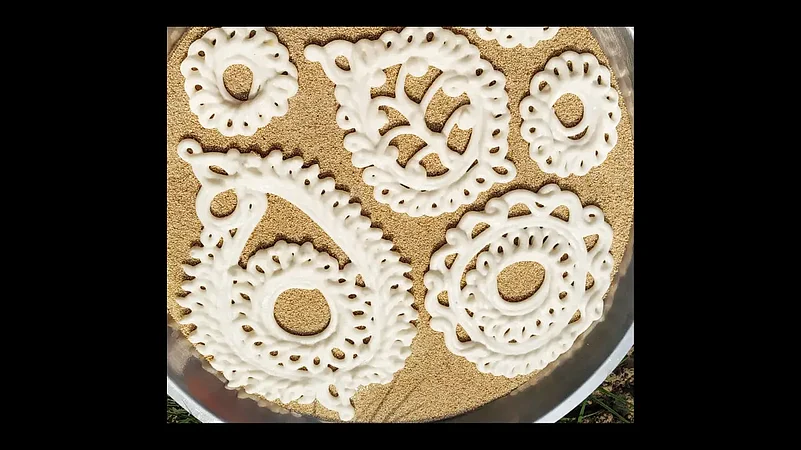As Nilina Ghosh deftly moved the piping bag filled with lentil paste over a plate neatly covered with poppy seeds, the ‘naksha’ (Bengali for ‘design’) began to take shape. First, she drew a few concentric circles and then filled in the vacant space with more geometric patterns. After adding a flourish of curlicue along the outer edge, she stopped. The simple circle now looked like a beautiful pendant fit for a bride. No wonder, this very edible artistic piece is called ‘gohona bori’ or ‘goyna bori’ (‘gohona’ or ‘goyna’ meaning jewellery in Bengali) in West Bengal, a specialty of its Purba Medinipur district.
Food Art From Bengal: Goyna Bori
The ornamental Goyna Bori from West Bengal can add an artistic to your meals

‘Bori’ making, undertaken by the women of the household, was once a common winter ritual followed in many Bengali homes. Even a few decades ago, it was one of the household arts that girls of marriageable age were supposed to master. Even today, women follow the rules of having a bath and wearing fresh clothes before commencing on the task. Before starting to make ‘bori’ for the household, women undertake a ritual involving the wedding of the ‘bori’ – where two specially made large pieces are covered with vermillion and offered prayers.
Traditionally, it was a manual process. Usually, a paste was made of ‘biuli’ or ‘kolai’ dal (Bengali for ‘urad’ dal). Seasoning was added to the batter, which was whisked by hand to make it light and fluffy. Then, by using the fingers, blobs of it would be delicately placed on a clean piece of cloth or an oiled plate in a particular fashion. The blobs would be left in the sun to dry. When dry, the blobs would be circular in shape with a wee conical tip. The expertise lay in perfecting the shape. The ‘bori’ would be stored around the year to be eaten as fries and added to a variety of dishes. Bori may also be made from ‘masoor’ and ‘matar’ dal. Sometimes ‘chalkumro’ (ash gourd/’petha’) is added to the batter – this is known as ‘kumro bori’.
Although nobody can say for sure how and when the humble ‘bori’ went the designer way, the fact remains that it came to be known as ‘gohona’ or ‘goyna’ bori owing to its similarity with intricately designed jewellery. A specialty from the Midnapur region of West Bengal, it has been in existence for a long time now. Nobel laureate poet Rabindranath Tagore and artists like Abanindranath Tagore and Nandalal Bose too set great stores by these highly decorative food items, writes food expert Utsa Roy in the book ‘Culinary Culture in Colonial India’. The ‘goyna bori’ owing to its size is eaten fried.
“However, with urbanisation and due to lack of time, the making of ‘goyna bori’ is a dying art,” said Mrinal Mandal, artist and founder of Chalchitra Academy, who had organised the workshop that winter morning “to revive the forgotten culinary art of rural Bengal.”
“Usually, the bori making takes place in winter,” said Sucheta Mandal, another teacher at the workshop and a resident of Midnapur town, ‘because the weather has to be cool and dry”.? “Whisking the batter to the right consistency is also important to make the perfect bori,” she explained.?
The making of ‘goyna bori’ is slightly different. A plate layered with poppy seeds is used to arrange the bori’. “One, it prevents the bori from sticking to the plate, and two, the thin layer of poppy seeds sticking to the bori gives the latter an extra crunch,” said Mandal. Some substitute poppy seeds with sesame. The design starts from the centre and moves outwards. Technology has made its inroads in this once totally manual process. The paste may be made in a household mixer and poured into a piping bag. In the rural areas, where piping bags are not common, the top of a toothpaste tube is snipped off, cleaned and ,used as a nozzle attached to a piece of cloth folded in the shape of a cone. Sometimes, a clean stick or a knitting needle is used to make the lines sharp and clear.
Along with Ghosh, who comes from Tamluk town, Mandal made beautiful patterns without referring to any kind of drawings or cheat sheets. Therefore, every ‘bori’ was unique in design. The shapes varied from circles to paisley to tear drops, to name a few.
Although a seasonal product, the ‘bori’ usually stays good for almost a year if it is kept in airtight containers and in absolutely dry condition. However, its brittleness is a deterrent to packing it for marketing. If you are lucky, you may find it being sold in local fairs and markets in West Bengal. Otherwise, you have to find out a friend or a relative who knows a ‘goyna bori’ maker.
-
Previous Story
 Tom Holland Recalls ‘Trip Of A Lifetime' Visiting India With Girlfriend Zendaya
Tom Holland Recalls ‘Trip Of A Lifetime' Visiting India With Girlfriend Zendaya - Next Story


















